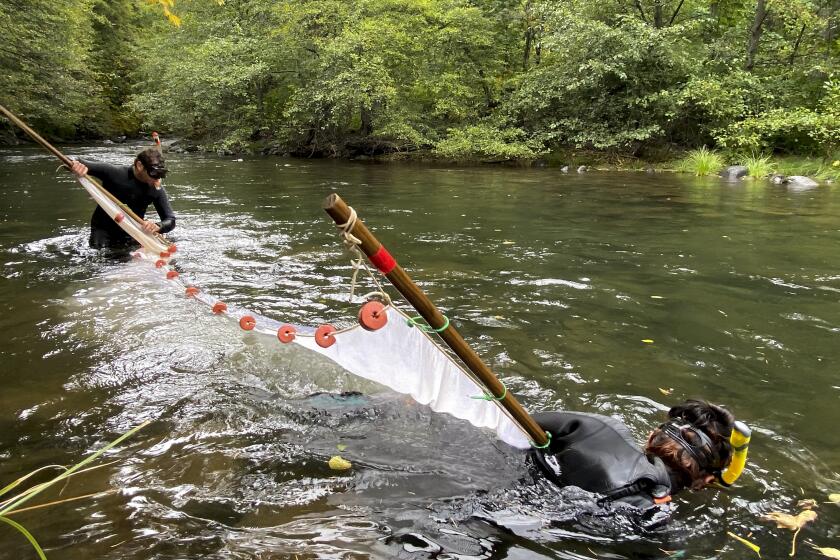Outdoor Notes / Pete Thomas : She Lands State-Record Bass, but It Isn’t Worth Its Weight
It was two weeks ago that Sandy DeFresco, fishing at San Diego’s Lake Miramar, landed the heaviest largemouth bass ever caught in California, but because of an unusual turn of events she would just as soon forget it.
At 21 pounds 10 ounces, her fish was also the heaviest largemouth caught since George Perry brought a 22-pound 4-ounce bass out of Georgia’s Montgomery Lake 26 years ago. DeFresco thought she would enter the fish with the Department of Fish and Game and have her name in the record books. Sounds simple enough.
“I was feeling great,” she said. “I was on Cloud Nine.”
What DeFresco didn’t know was that there was something irregular about the fish: A taxidermist discovered a 2-pound 8 3/4-ounce lead weight lodged in the stomach of the fish. Simple subtraction puts the natural weight of her bass at 19 pounds 1 ounces, still big for a bass but shy of the state-record catch of 21 pounds 3 ounces, set in 1980 by Fullerton’s Ray Easley at Lake Casitas in Ventura County.
“That really embarrassed me,” DeFresco said. “I wish I had never caught the fish.”
DeFresco, 47, was cleared of any wrongdoing by DFG biologist Larry Bottroff, who said the weight--possibly from a diver’s belt--had been in the lunker’s stomach for as long as two weeks, adding that the bass must have somehow ingested it. “I examined the stomach of DeFresco’s bass,” Bottroff said. “I wanted to be sure that the weight hadn’t been added to the fish after it was caught. Sure enough, tissue was forming around the weight inside the fish (indicating it had been there a while). It’s the most unique thing I’ve ever seen with big bass.”
While Bottroff said he would recommend to the Fish and Game Commission that the bass be recognized as a state record, DeFresco, a concession manager at the lake, said she is no longer interested.
“I have no intention of submitting the fish now,” she said. “I just wouldn’t feel right about it.”
When asked about having her pride humbled by the unfortunate discovery, the self-proclaimed fishing veteran said: “It was still 21-10 (pounds) coming up. Besides, how many people even catch a 19-pound bass? Not very many.”
The transplanting of 70 California sea otters from Monterey to San Nicolas Island last August has been the subject of debate in recent weeks, but no one argued with the action taken recently by a Monterey judge against two Salinas residents charged with the take and destruction of one of the otters.
On March 4, Municipal Court Judge Alan Hedegard sentenced Robert Gene Garcia, 29, to six months in jail and fines totaling $1,900. Elizabeth Jane Vallez, 24, was fined $1,000 for allowing an otter to be transported in her car.
Both were accused of taking the otter from the beach near Moss Landing, attempting to skin it, and then dumping the dead animal in a Salinas gutter. The conviction was the first in 18 years for the taking of a sea otter.
Meanwhile, environmental groups have questioned the DFG’s relocation effort--designed to help preserve the species should something happen to the original colony--after recent reports of dead or missing otters off their new San Nicolas Island home.
State wildlife officials, armed with helicopters and nets, captured 11 California bighorn sheep in the Sierra Nevada Mountains and transplanted them Wednesday into the back country near Yosemite to augment a dwindling herd.
Eight ewes and three rams moved by airlift from the slopes of Mount Baxter on the Fresno-Inyo County line to Lee Vining Canyon near Yosemite National Park’s eastern boundary as part of an ongoing effort to keep the animals alive on their native ranges.
A little more than 300 California bighorn sheep remain in five Sierra Nevada locations.
Members of the Sierra Nevada Bighorn Sheep Recovery Program had hoped to transport 19 of the animals to Lee Vining Canyon. All of the captured animals were fitted with radio collars so biologists can track the herd’s movements through the rocky terrain.
The plan to save the bighorns, listed as “threatened” on the California endangered species list, has been criticized by officials who claim the sheep will die from diseases passed by nearby flocks of domestic sheep.
Dr. Ted Kistner, a professor of veterinary medicine at Oregon State University, told the Associated Press that the future of the population doesn’t look bright.
“There are domestic sheep nearby, as well as a major highway,” he said. “Bighorn can’t tolerate either domestic sheep or visual stress from people.”
About 55 bighorn sheep in the Warner Mountains in Northern California have died since December due to a disease contracted from domestic sheep, according to Fish and Game officials.
The Lee Vining herd was established in 1986 with 27 bighorns, but has dwindled to 22 animals despite the birth of 19 lambs. Five sheep splintered off and began roaming in Bloody Canyon, south of Lee Vining Canyon.
Biologists say stress, mountains lions and other problems have been factors in the herd’s tenuous history.
Briefly
The DFG reminds grunion hunters that a closure will be in effect during the months of April and May to allow the fish to spawn freely. . . . Canadian fly-fishing guide Rick Harding will present a show on fly fishing for rainbow trout in Calgary’s Bow River at the Sierra Pacific Flyfishers’ April 21 dinner meeting at the Odyssey Restaurant in Mission Hills. For more information, call (818) 785-7306. . . . The Streamborn Flyfishing Club is offering a free beginning fly-tying class on six consecutive Mondays, beginning April 4 at 7:30 p.m. in the community room of the Pomona First Federal Savings and Loan Assn. in Rowland Heights. For more information, call (818) 964-9571.



